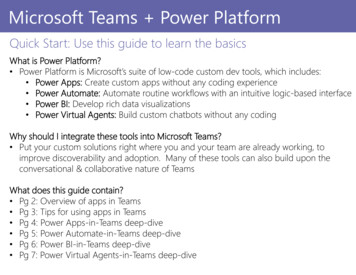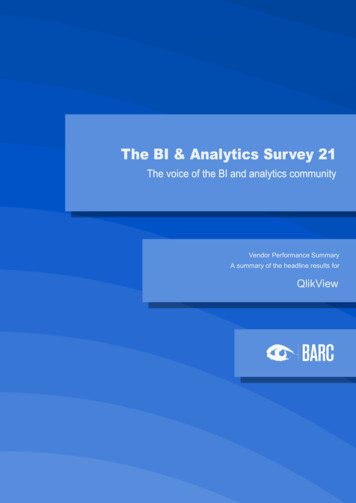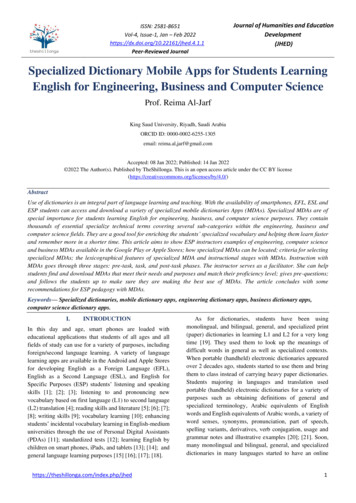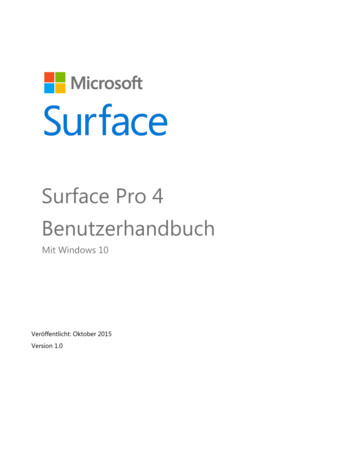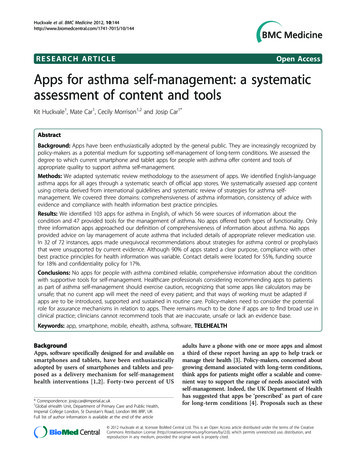
Transcription
Huckvale et al. BMC Medicine 2012, 4RESEARCH ARTICLEOpen AccessApps for asthma self-management: a systematicassessment of content and toolsKit Huckvale1, Mate Car1, Cecily Morrison1,2 and Josip Car1*AbstractBackground: Apps have been enthusiastically adopted by the general public. They are increasingly recognized bypolicy-makers as a potential medium for supporting self-management of long-term conditions. We assessed thedegree to which current smartphone and tablet apps for people with asthma offer content and tools ofappropriate quality to support asthma self-management.Methods: We adapted systematic review methodology to the assessment of apps. We identified English-languageasthma apps for all ages through a systematic search of official app stores. We systematically assessed app contentusing criteria derived from international guidelines and systematic review of strategies for asthma selfmanagement. We covered three domains: comprehensiveness of asthma information, consistency of advice withevidence and compliance with health information best practice principles.Results: We identified 103 apps for asthma in English, of which 56 were sources of information about thecondition and 47 provided tools for the management of asthma. No apps offered both types of functionality. Onlythree information apps approached our definition of comprehensiveness of information about asthma. No appsprovided advice on lay management of acute asthma that included details of appropriate reliever medication use.In 32 of 72 instances, apps made unequivocal recommendations about strategies for asthma control or prophylaxisthat were unsupported by current evidence. Although 90% of apps stated a clear purpose, compliance with otherbest practice principles for health information was variable. Contact details were located for 55%, funding sourcefor 18% and confidentiality policy for 17%.Conclusions: No apps for people with asthma combined reliable, comprehensive information about the conditionwith supportive tools for self-management. Healthcare professionals considering recommending apps to patientsas part of asthma self-management should exercise caution, recognizing that some apps like calculators may beunsafe; that no current app will meet the need of every patient; and that ways of working must be adapted ifapps are to be introduced, supported and sustained in routine care. Policy-makers need to consider the potentialrole for assurance mechanisms in relation to apps. There remains much to be done if apps are to find broad use inclinical practice; clinicians cannot recommend tools that are inaccurate, unsafe or lack an evidence base.Keywords: app, smartphone, mobile, ehealth, asthma, software, TELEHEALTHBackgroundApps, software specifically designed for and available onsmartphones and tablets, have been enthusiasticallyadopted by users of smartphones and tablets and proposed as a delivery mechanism for self-managementhealth interventions [1,2]. Forty-two percent of US* Correspondence: josip.car@imperial.ac.uk1Global eHealth Unit, Department of Primary Care and Public Health,Imperial College London, St Dunstan’s Road, London W6 8RP, UKFull list of author information is available at the end of the articleadults have a phone with one or more apps and almosta third of these report having an app to help track ormanage their health [3]. Policy-makers, concerned aboutgrowing demand associated with long-term conditions,think apps for patients might offer a scalable and convenient way to support the range of needs associated withself-management. Indeed, the UK Department of Healthhas suggested that apps be ‘prescribed’ as part of carefor long-term conditions [4]. Proposals such as these 2012 Huckvale et al; licensee BioMed Central Ltd. This is an Open Access article distributed under the terms of the CreativeCommons Attribution License (http://creativecommons.org/licenses/by/2.0), which permits unrestricted use, distribution, andreproduction in any medium, provided the original work is properly cited.
Huckvale et al. BMC Medicine 2012, 4motivate a question about whether current apps aresuitable for this kind of use.We address this by focussing on apps for asthma as arepresentative long-term condition. Asthma is common,globally-relevant, managed substantially in primary careand amenable to self-management. Moreover, while boththe content of asthma self-management education hasbeen well described in UK [5], US [6] and international[7] evidence-based guidelines, and its positive impact onoutcomes demonstrated [8], the best way to communicate information and support its use through tools is lessclear. Established methods such as face-to-face educationand paper-based tools are inconsistently applied. Forexample, in the UK, only 20% of patients have everreceived a written action plan [9]. Meanwhile, peoplewith asthma are looking for alternatives; 65% report having used the internet to locate information about asthmawithout necessarily involving a health professional.Taken together, these create a specific opportunity fornew methods to support self-management education.This opportunity can only be realized if apps offer content and tools of appropriate quality. We adapted principles from systematic literature reviews to assess thecontent quality of smartphone and tablet apps for asthmaagainst objective criteria derived from evidence-basedguidelines [5]. We discuss our findings about asthmaapps in relation to the wider policy context of prescribingapps to support the care and management of long-termconditions.MethodsSelection of appsWe aimed to identify all apps for asthma accessible toEnglish-speaking patients. We searched the official appstores for Android, Apple, Blackberry and WindowsPhone using the following terms: asthma, lung function,peak flow and inhaler. Apps were downloaded to testdevices for screening by two authors (KH and MC) working independently using predefined inclusion and exclusion criteria (Figure 1). Test devices were unmodifiedconsumer-grade smartphones running up-to-date versions of their mobile operating system. The same versionof each app was used throughout testing.Planned assessment criteriaBasic details were extracted into a standard form (Additional file 1). Assessment was performed by two authors(KH and MC) assessing each app in a random order.For apps presenting health information about asthma,we assessed two domains: the comprehensiveness of information about asthma and consistency of information withevidence-based guidelines on asthma. To assess comprehensiveness, we assessed coverage of eight topics recommended as the basis of self-management education andPage 2 of 11that are consistent across UK, US and international guidelines [5-7] (Table 1). For each topic, we assessed coverageas either ‘complete’, ‘partial’ or ‘absent’. To evaluate consistency with evidence-based guidelines, we extracted a setof specific statements relating to secondary prevention andlifestyle advice from the same guidelines (Table 2). Foreach statement, we also captured the direction of theguideline recommendation indicating whether a particularstrategy was ‘beneficial’, ‘not beneficial’ or whether therewas insufficient or unclear evidence to be able to make aspecific recommendation. To ensure fair assessment ofapps sourced from multiple countries of origin, weretained only those statements considered by all threeinternational guidelines used in the review. App contentwas reviewed and information corresponding to particularstatements was assessed to see if any recommendation wasconsistent with that of the guidelines. Advice about actionsfor lay people to take during an asthma attack was compared separately against guidance on initial medical management for those aged two and older [5].We used the US National Center for Complementaryand Alternative Medicine definition of Complementaryand Alternative Medicine (CAM) [10] to define a group ofapps that were not assessed for either comprehensivenessor consistency with evidence since these concepts are notconsistently recognized in CAM practice. However, weretained these apps within the overall descriptive summaryof app types and, specifically, for assessment of emergencymanagement advice because of the particular risks associated with acute asthma.In addition to those with information content, we anticipated that we would find apps offering diary features andplanned to assess compliance with the recommendationsof a recent systematic review concerning the componentsof self-management plans [11]. We also assessed appsusing a set of content-independent quality criteria that wederived from an existing set of criteria for website-basedhealth information developed by the Health on the Netfoundation [12] (Table 3). These define a set of eight bestpractice principles relating to attribution, traceability andtransparency of information. For apps that lacked attribution, we used general purpose internet search engines(Google, Google Incorporated, Mountain View, CA, USAand Bing, Microsoft Corporation, Redmond, WA, USA) toattempt to locate original authors for written content.Each reviewer recorded their responses in a structuredform. These were compared and any discrepancies wereresolved by discussion. Throughout the assessment process, we kept a record of any problems using the softwarethat were encountered using a general schema to classifyerrors (Table 4).Post-hoc assessmentsAn additional analysis was performed to assess theproperties of calculator and questionnaire-based apps
Huckvale et al. BMC Medicine 2012, 4Page 3 of 11In c lu s io n c r it e r iaS m a r t p h o n e o r t a b le t a p pC o n te n tort o o lsa d d re s s in goneorm o rea sp e ctsofa sth m ad ia g n o s is ,m a n a g e m e n t o r s u p p o r t a s e it h e rot h e s o le f u n c t io n ; o roin a w a y t h a t m e a n s a s t h m a -r e la t e d e le m e n t s c a n b e is o la t e d f ro m t h e r e s to f th e co n te n tP r e s e n t in g c o n t e n t in a n y fo r m a tE n g lis h la n g u a g eTa r g e t e d a t p a t ie n t s o f a n y a g eF r e e a n d p a id a p p sE x c lu s io n c r it e r iaN o t a v a ila b le t h ro u g h a n a p p ro v e d d e v ic e m a r k e t p la c eE x p lic it ly d is c la im e d u s e fo r a h e a lt h - re la te d p u r p o s eC o u ld n o t b e d o w n lo a d e d b e c a u s e o f c o u n t r y r e s t r ic t io n s t h a t p r e v e n t e d a c c e s s int h e U n it e d K in g d o mC o u ld n o t b e u s e d b e c a u s e o f t e c h n ic a l p ro b le m s , a f t e r t w o a t t e m p t sFigure 1 Inclusion and exclusion criteria for smartphone apps.that were not anticipated during study planning. In eachcase, we looked for evidence of external validation [13].We also tested the calculators and any questionnairescoring to confirm that these were numerically correct.were designed for smartphones. Although all iPhoneapps can run on the iPad tablet, we found eight thatincluded specific customizations to take advantage of thelarge screen size and one that was a tablet-only app.StatisticsSummary of characteristics of included appsDescriptive statistics were used to summarize the resultsof the content assessment.Fifty-six apps were sources of written (n 43) and multimedia (n 13) information about asthma and its management [14-69]. The remaining 47 were tools supportingaspects of asthma self-management and included diaries(n 29), assessment instruments (n 17) and locationbased alerts (n 6) [70-115]. Although we neitherexpected nor required that assignment into these twomain categories be mutually exclusive, we found no English-language apps that combined both information andmanagement tools. (A typology is provided in Additionalfile 3.) Sixty-one percent (n 34) of information apps and96% (n 45) of management tools focussed on conventional medical management of asthma. Nineteen appsResultsSearches performed in August 2011 identified 207 appsfrom the app stores for Android, Apple, Blackberry andWindows Phone, of which 204 were available for screening (Figure 2). We excluded 101 that either contained nohealth or asthma-related content (n 57), targeted clinicians (n 35), were not in English (n 7), or could notbe started (n 2). Excluded apps are summarized inAdditional file 2. Subsequent discussion is restricted tothe 103 apps that met inclusion criteria. Most (n 94)
Huckvale et al. BMC Medicine 2012, 4Page 4 of 11Table 1 Items that should be addressed by comprehensive asthma self-management education materialsTopicCriteriaBasic facts about the nature of the condition States that asthma is a lung disease characterized by inflammation and narrowing of the airwaysStates that the four main symptoms of asthma are cough, wheeze, shortness of breath and chesttightnessStates that asthma cannot be cured (although childhood symptoms may remit) but can beeffectively controlledStates that the cause of asthma is not knownThe nature of treatment: relievers andpreventersStates that there are two classes of medication: relievers and preventersExplains possible side effects of medication (tachycardia/tremor in Β2 agonists; thrush/cataracts/dysphonia for inhaled steroids; possible additional effects for high dose steroids)States that early treatment can prevent symptoms from worseningAllergen and trigger avoidanceStates that recognizing and avoiding personal triggers is an important part of asthma controlProvides guidance consistent with the primary and Secondary prevention components of the BTS/SIGN guidelines in relation to specific triggersHow to use treatmentStates that preventer medication must be used regularly to be effectiveStates the importance of good inhaler technique and appropriate use of a spacer deviceStates the importance of ensuring inhalers are in date and are not emptySelf-monitoring and assessment skillsStates that learning to recognize signs of change in asthma symptoms is an important personal skillStates that all patients with asthma should have a peak flow meterExplains the purpose of a peak flow meter and how to use itStates the importance of regular physician reviewThe role of a written, personalized actionplanStates that patients with asthma should have an up to date written action plan. Explains the purposeof an action plan (to step up and step down treatment, and to seek appropriate help in response tochanging symptoms and/or peak flow)Recognizing and responding appropriately to Describes signs/symptoms of worsening asthma (increasing wheeze; cough; night time disturbanceacute exacerbationsbreathlessness limiting activity; reliever inhalers not working)States the importance of changing treatment and/or seeking help promptlyLay management of acute asthmaPersonalizing the definition of good asthmacontrolStates that it is reasonable for most people to achieve minimal symptoms and limitation of activitiesAsks patients to reflect on what they would consider as good asthma controlAdvocates discussion with personal health provider to set treatment goals in partnershipTopics were based on UK BTS/SIGN, US EPR-3 and GINA guidelines.considered exclusively CAM, while five integrated contentaddressing both approaches. Seven apps targeted eitheryounger children [38,89] or their parents [16,27,106-108].None targeted adolescents or elderly patients.After including any in-app purchases required to accessasthma-specific content, the majority of apps (n 76/103)were not free with a median cost of 1.49 (mean 1.85,range 0.61 to 8.99). Apps offering management toolswere more likely to be free (n 19/47) compared to thosepresenting health information (n 8/56).Apps presenting health informationApps presenting health information are summarized inAdditional file 4.Comprehensiveness of asthma informationExcluding apps exclusively addressing CAM, 38 apps wereevaluated for comprehensiveness of asthma ,67]. The basic nature of asthma, including the role of inflammation, symptoms and prognosis was the most commonly addressed (atleast partially), by two-thirds of apps (n 26, breakdown inAdditional file 5). Allergen and trigger avoidance were discussed by 18 but only covered in depth by 2 [25,63]. Lessthan two-fifths addressed recognition of exacerbations(n 14), self-monitoring (n 10) and inhaler techniques(n 10). Customized aspects of asthma management,including the role of an action plan and the prioritizationof treatment goals according to patient wishes, wereaddressed least frequently by seven and three apps, respectively. Three apps wholly addressed six of the eightdomains and provided partial coverage of the remainingtwo [19,59,63].Lay management of acute asthmaOf the 14 medical apps containing conventional information about recognition and management of acute asthma[20,25,28,29,33-37,49,58,59,63,64], 7 provided specificguidance on lay management of an asthma attack.Although none addressed all aspects of the step-wiseapproach recommended by guidelines, six gave advicethat was broadly consistent [33-36,49,63] but lacked specific instructions on the dose and frequency of relieverinhaler use (addressed by n 2/6) or the appropriatemedical service to contact (addressed by n 2/6). Oneapp provided guidance that substantially differed fromrecommendations [29].Eight apps suggested CAM procedures for acuteasthma management [35,36,48,51,52,60,62,65]. Nonerecommended using a beta-agonist reliever inhaler or
Huckvale et al. BMC Medicine 2012, 4Page 5 of 11Table 2 Evidence-based statements extracted from international guidance used to assess compliance with evidencebased recommendations.StatementEvidence- Rationale for categorizationbaseSecondary prevention-removal of petsfrom the homeUncertain“Complete avoidance of pet allergens is impossible [.] Although removal of such animalsfrom the home is encouraged, even after permanent removal of the animal it can be manymonths before allergen levels decrease and the clinical effectiveness of this and otherinterventions remains unproven.” [7] “The reported effects of removal of pets fromhomes are paradoxical, with either no benefit for asthma, or a potential for continuedhigh exposure to induce a degree of tolerance.” [5] [EPR-3 suggests that animal removalcould be considered but rates the evidence Grade D which reflects panel consensus only][6]Secondary prevention-fungal allergenavoidance and control measuresUncertain“Air conditioners and dehumidifiers may be used to reduce humidity to levels less than50% and to filter large fungal spore. However, air conditioning and sealing of windowshave also been associated with increases in fungal and house dust mite allergens.” [7]“Although fungal exposure has been strongly associated with hospitalisation and increasedmortality in asthma, no controlled trials have addressed the efficacy of reduction offungal exposure in relation to control of asthma.” [5] “The Expert Panel recommendsconsideration of measures to control indoor mold [.] but the relative contribution offungi, house-dust mites or irritants [to asthma symptoms] is not clear.” [6]Secondary prevention-cockroach avoidance Uncertainand control measures“[Measures for cockroach control] are only partially effective in removing residualallergens.” [7] “Cockroach allergy is not a common problem in the UK and studies ofattempts to avoid this allergen elsewhere have produced conflicting results.” [5] [EPR-3recommends cockroach control if the patient is sensitive to cockroaches]. [6]Secondary prevention-cessation of activesmoking“Secondhand smoke increases the frequency and severity of symptoms in childrenwith asthma.” [7] “Direct or passive exposure to cigarette smoke adversely affects qualityof life, lung function, need for rescue medications for acute episodes of asthma and longterm control with inhaled steroids.” [5] “[Smoke exposure] is associated with increasedsymptoms, decreased lung function, and a greater use of health services amongthose who have asthma.” [6]BeneficialSecondary prevention-avoidance of passive Beneficialsmoking“Asthma patients who smoke and are not treated with inhaled glucocorticosteroids, have agreater decline in lung function than asthmatic patients who do not smoke.” [7] “Direct orpassive exposure to cigarette smoke adversely affects quality of life, lung function, needfor rescue medications for acute episodes of asthma and long term control with inhaledsteroids.”[5] “[Smoke exposure] is associated with increased symptoms, decreased lungfunction, and a greater use of health services among those who have asthma.” [6]Secondary prevention-avoidance ofexposure to air pollutionUncertain“Avoidance of unfavourable environmental conditions is usually unnecessary for patientswhose asthma is controlled.” [7] “While it might seem likely that moving from a highlypolluted environment might held, in the UK, asthma is more prevalent in 12-14 yearolds in non-metropolitan rather than metropolitan areas.” [5] “Clinicians [should] advisepatients to avoid, to the extent possible, exertion or exercise outside when levels of airpollution are high.” [6]Secondary prevention-immunotherapy fora defined allergenBeneficial“Appropriate immunotherapy requires the identification and use of a single welldefined clinically relevant allergen.” [7] “Immunotherapy can be considered in patientswith asthma where a clinically significant allergen cannot be avoided.” [5]“Immunotherapy [should] be considered for patients who have persistent asthma ifevidence is clear of a relationship between symptoms and exposure to an allergen.”[6]Secondary prevention-weight reduction inobese patientsBeneficial“Weight reduction in obese patients with asthma has been demonstrated to improve lungfunction, symptoms, morbidity and health status.” [7] “One randomised parallel groupstudy has shown improved asthma control following weight reduction in obesepatients with asthma.” [5] “Obesity has been associated with asthma persistence andseverity in both children and adults. [.W]eight loss in adults resulted in improvement inpulmonary mechanics, improved FEV1, reductions in exacerbations and courses of oralcorticosteroids and improved quality of life.” [6]Secondary prevention-seasonal influenzavaccinationUncertain“Patients with moderate to severe asthma should be advised to receive an influenzavaccination every year [.] however routine influenza vaccination of children andadults with asthma does not appear to protect them from asthma exacerbations orimprove asthma control.” [7] “Immunisations should be administered independent ofany considerations related to asthma.” [5] “[We recommend] that clinicians considerinactivated influenza vaccination for patients who have asthma [.] however the vaccineshould not be given with the expectation that it will reduce either the frequency orseverity of asthma exacerbations during the influenza season.” [6]Statements were extracted from the UK BTS/SIGN, US EPR-3 and international GINA guidelines.’Uncertain’ was used when either all three guidelines agreed that the evidence base was uncertain or where the advice given by the guidelines differed. Weretained only topics discussed by all three sets of guidelines.
Huckvale et al. BMC Medicine 2012, 4Page 6 of 11Table 3 Health information best-practice principles adapted for smartphone apps1 Information must be authoritative: all medical information presented by [and/or calculations performed by an app] must be attributed to anauthor and his/her training in the field must be mentioned.2 Purpose [of the app]: A statement clearly declaring that the [app] is not meant to replace the advice of a health professional has to be provided.A brief description of the [app]’s mission, purpose and intended audience is necessary. Another brief description of the organisation behind the[app], its mission and its purpose is also necessary.3 Confidentiality: The [app publisher] must describe its privacy policy regarding how you treat confidential, private or semi-private information suchas email addresses and the content of emails received from or sent to [its users]4 Information must be documented, referenced and dated: All medical content [including calculations and formulae] has to have a specific date ofcreation and a last modification date.5 Justification of claims: All information about the benefits or performance of any treatment (medical and/or surgical), commercial product orservice are considered as claims. All claims have to be backed up with scientific evidence (medical journals, reports or others).6 [App] contact details: The [app] must be operational and the information must be accessible and clearly presented. There must be a way tocontact the [app publisher], such as a working email address or contact form, for visitors who would like to have more details or support.7 Funding: [The app publisher] must include a statement declaring its sources of funding.8 Editorial and advertising policy: Conflicts of interest and external influences which could affect the objectivity of the editorial content must beclearly stated in the disclaimer. All [apps] displaying paying banners have to have an advertising policy. This policy must explain how the[publisher] distinguishes between editorial and advertising content and which advertisements are accepted. Any conflict of interest has to beexplained.Adapted from the Health on The Net Foundation principles for health information on the internet.seeking conventional medical help should an alternativeemergency procedure prove ineffective, although twocontained details of conventional emergency management in separate sections [35,36].Compliance of information with evidence-basedrecommendationsWe identified 72 instances where apps addressed itemsfrom our pre-defined set of evidence-based recommendations. Of these app-statements, 40 were asserted in linewith current guidance. In all other cases (n 32), appsappeared to unequivocally recommend a particular courseof action where there is current uncertainty. Statementsconcerning active and passive smoke avoidance (exacerbates symptoms, n 12 and 13), weight reduction in obesity (beneficial for asthma symptoms, n 7) and thepotential utility of immunotherapy (can be consideredwhere a specific allergen is identified, n 2) were correctlyasserted by all apps that mentioned them. Recommendations about behavioural strategies for the avoidance of airpollution (n 9), fungal allergens (n 9), removal (ratherthan control of) pets (n 5) and cockroach control (n 7)were all delivered more variably (breakdown in Additionalfile 6). An unequivocal recommendation for flu vaccination was made by five of six apps.A small number of apps actively cautioned against allopathic medical management. Four apps [18,52,60,66]recommended avoiding conventional medical management because of the risks of side effects, addiction andworsening of the condition.Apps providing tools for the management of asthmaDiariesTwenty-nine apps offered functions for patients to tracktheir asthma (Additional file 7[70-98]). Diaries differed inTable 4 Classes of software issue considered during assessmentIssue typeDescriptionExample(s)Data entryvalidationData can be entered that are out-of-range or inappropriate. Newdata can overwrite existing data without warning.Negative values of peak flow can be entered and are stored.New entries can overwrite existing data without warning.FunctionalityA function of the app (for example, saving data, performing acalculation) does not operate as expected.App miscalculates the score of Asthma Control Test foradults; app displays an ‘unfortunately you did not beat yourhighest score’ message even if score is 100%.Presentationand userinterface (UI)Content having spelling and layout mistakes. User interface controls(for example, textboxes, labels, buttons) are mislabelled, inoperativeor inaccessible. Navigation between different parts of the app doesnot occur as expected or can lead to the user getting stuck on aparticular screen.Some controls hidden when opened on a lower resolutionscreen; text box for recording peak flow labelled as ‘PeekFlow’; some user controls not labelled in English.CrashThe app stopped responding in a timely way to user input or wasApp crashed when a backup of data entered by the userclosed unexpectedly by the smartphone or tablet operating system. was attempted.OtherAny other software issue, for example an online or other dataservice (for example, a website that the app uses for data) isunavailable or does not work as expected.Some linked content that is displayed within the app onallergens is broken; GPS function does not work.The table summarizes the classes of error used for assessment and provides illustrative examples based on those observed during the appraisal process.
Huckvale et al. BMC Medicine 2012, 4Page 7 of 111Figure 2 Flowchart of app selection process.terms of the information that they captured and theoptions given to patients for manipulating the recordeddata. While a small number of diaries captured eitherasthma symptoms (n 2 [87,88]) or peak flow (n 2[93,94]) alone, the majority (n 23) allowed both symptoms and peak flow values to be recorded as well asrecent medication use (n 24). Most apps relied on manual entry of data; however, one [92] was able to sourcevalues from a Bluetooth-enabled peak flow meter andanother (available on both iPhone and Windows Phone)from a wireless inhaler [96,97] (untested in this review).Fifty-nine percent of (n 17 of 29) diary apps la
management. We covered three domains: comprehensiveness of asthma information, consistency of advice with evidence and compliance with health information best practice principles. Results: We identified 103 apps for asthma in English, of which 56 were sources of information about the condition and 47 provided tools for the management of asthma.


